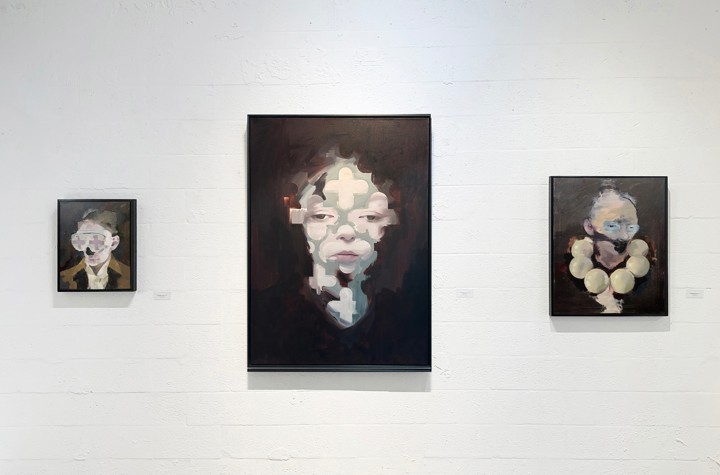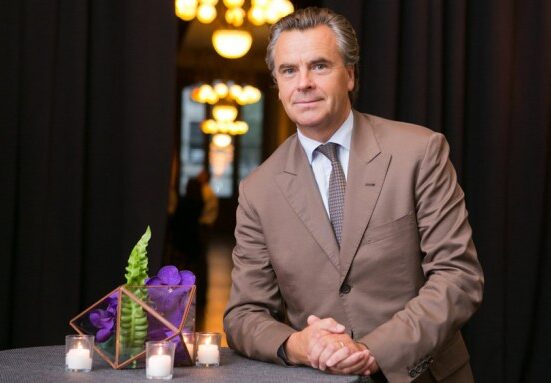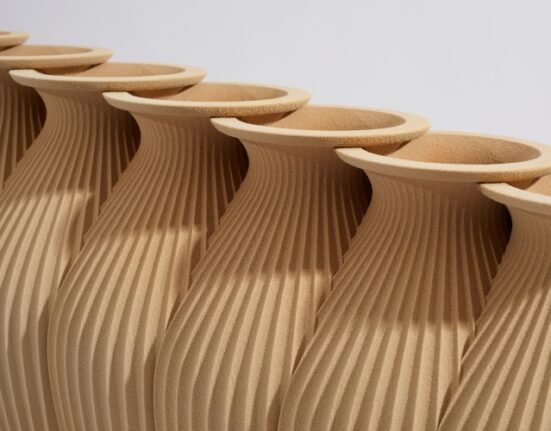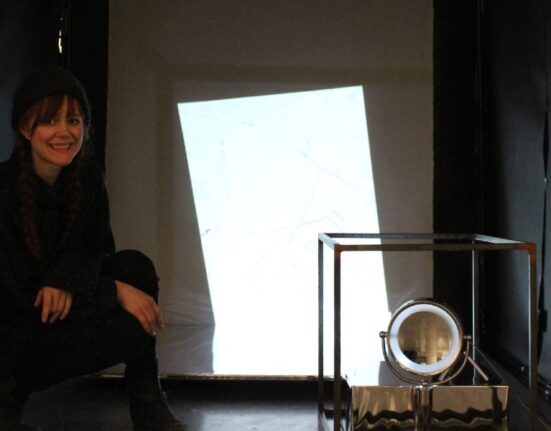 Richard Butler with his paintings. Photo courtesy of the artist and Aliona Ortega Fine Art, Miami.
Richard Butler with his paintings. Photo courtesy of the artist and Aliona Ortega Fine Art, Miami.
By WENDY M. BLAZIER November 14, 2023
“When I was a child in rural England, starlings would flock in the thousands on telephone wires. It presaged the beginning of winter, and it invoked a certain sense of melancholy. I would like to think the paintings do the same — a certain sense of beauty, yet sadness at the same time,” says the artist Richard Butler (1).
Songs for starlings — the title Butler has given this exhibition — like the metaphorical language of birds, speaks truths about our lives. And just as with the songs of birds, an exact reading of Butler paintings is impossible. Meaning is only insinuated by a few visual clues. In some ways, Butler’s paintings become allegorical stories full of paradoxes and riddles. And the riddle starts with the artist himself.
Richard Butler is an artist whose work ranges from painting to music. Born in London, England in 1956, his first love was painting. He studied at a leading art college in the United Kingdom, the Epsom School of Art and Design (now Surrey Institute of Art & Design, University College) just southwest of central London. Shortly after graduating in 1977, he became a founder, the lead singer and songwriter of the British post-punk/new wave band The Psychedelic Furs. Quickly gaining critical and commercial success, Butler’s musical career invariably eclipsed his life as a painter for almost two decades (touring internationally and releasing nine studio albums and two live albums over 40 years). In the 1990s, while touring worldwide, Butler returned to his first love of painting, and has steadily built a body of work, which is both intimate and universal in its appeal.
Although reticent to discuss it, Butler’s music and paintings are inextricably linked. Butler’s music is known as artistic, dark and atmospheric, with introspective lyrics. “I never really think of my painting and music being connected. If pressed, I would say that both share a certain melancholy” (2).
Butler’s paintings are expressions of his inner world, a reflection of his own personal journey, and born from his thoughts on love, loss, identity, doubt, alienation, and the human condition.
“Love my way, it’s a new road I follow where my mind goes,
So swallow all your tears my love
And put on your new face…” (3)
Part introspection, part confession, part invention, part dream: Butler’s paintings are unabashedly emotional. He is engaged in the vicissitudes of the constructed image, that is, the image’s change and evolution, the metamorphosis from one context to another – from youth and innocence to the constrictions of life’s lessons and the consequences of those changes.
‘The Hollow Men’ (1925) is a poem by T.S. Eliot (4) that explores themes of religious confusion, despair, and the state of the world in disarray. But unlike the spiritual decay of Eliot’s hollow men “stuffed with straw” and empty of substance, Butler’s subjects resist the abyss of absolute nothingness, and instead, reach for a feeling of wistful melancholia and mystery.
 Richard Butler Satyratthegatesofhell, 2023. Oil on linen, 20 x16 in. Courtesy of the artist and Aliona Ortega Fine Art, Miami.
Richard Butler Satyratthegatesofhell, 2023. Oil on linen, 20 x16 in. Courtesy of the artist and Aliona Ortega Fine Art, Miami.
Portraits
Every Richard Butler painting is a portrait. Butler explains, “…a portrait has a focus and a presence, and as much as I might like to look at a picture of flowers by Chardin, it does not have the immediacy of a Rembrandt or a Holbein. The skin tones, the fact that it is a person—I want to try to do that” (5).
Making his unhurried way along the most heavily trodden path of painting — that of portraiture — Butler’s portraits are dark, somber, mysterious and connected somehow to our collective anxieties. Butler prompts the viewer to experience them, to be conscious of following the rules, implicit and explicit, that lend coherence to images, literary and historic references, and tradition.
The great Irish poet and playwright Oscar Wilde (1854-1900) said, “Every portrait that is painted with feeling is a portrait of the artist, not of the sitter. The sitter is merely the accident, the occasion. It is not he who is revealed by the painter; it is rather the painter who, on the coloured canvas, reveals himself” (6).
“My images surprise me,” says Butler. “Although, there is always a ‘recognition’ —recognition of myself I suppose. In a way I think all of my paintings are self-portraits in that though the face I am painting may not be my own, the feeling I get back from the painting is certainly an important element of my own psyche. Hence the ‘recognition.’” The psyche of the artist — the mind, the soul, and the spirit — is revealed through the semiotics of images as meaning.
Richard Butler’s paintings are his songs for starlings. And we are the starlings.
“Go, go, go, said the bird: human kind
Cannot bear very much reality.
Time past and time future.
What might have been and what has been
Point to one end, which is always present.”
— T.S. Eliot (7)
Since antiquity, migrating birds have been seen as souls and symbols of freedom. According to the Koran, the “language of birds” is spiritual knowledge, and is related to the soul. In Abrahamic and European traditions, the language of birds is postulated as a mystical, perfect and divine language. Migrating birds – such as those of 12th-century Sufi poet Farid ud-Din Attar in his fable The Conference of the Birds (8), and those of 10th-century Islamic philosopher and physician Avicenna’s (980-1036) allegorical Recital of the Bird – are souls searching for redemption (9). As symbols of freedom, intelligence, courage, and transcendence, birds have historically connected the past with the present and the future. Moving in flocks of thousands, searching for a place to land, migrating the continents, huge flocks of starlings speak many languages, mimicking words and noises and the songs of other birds.
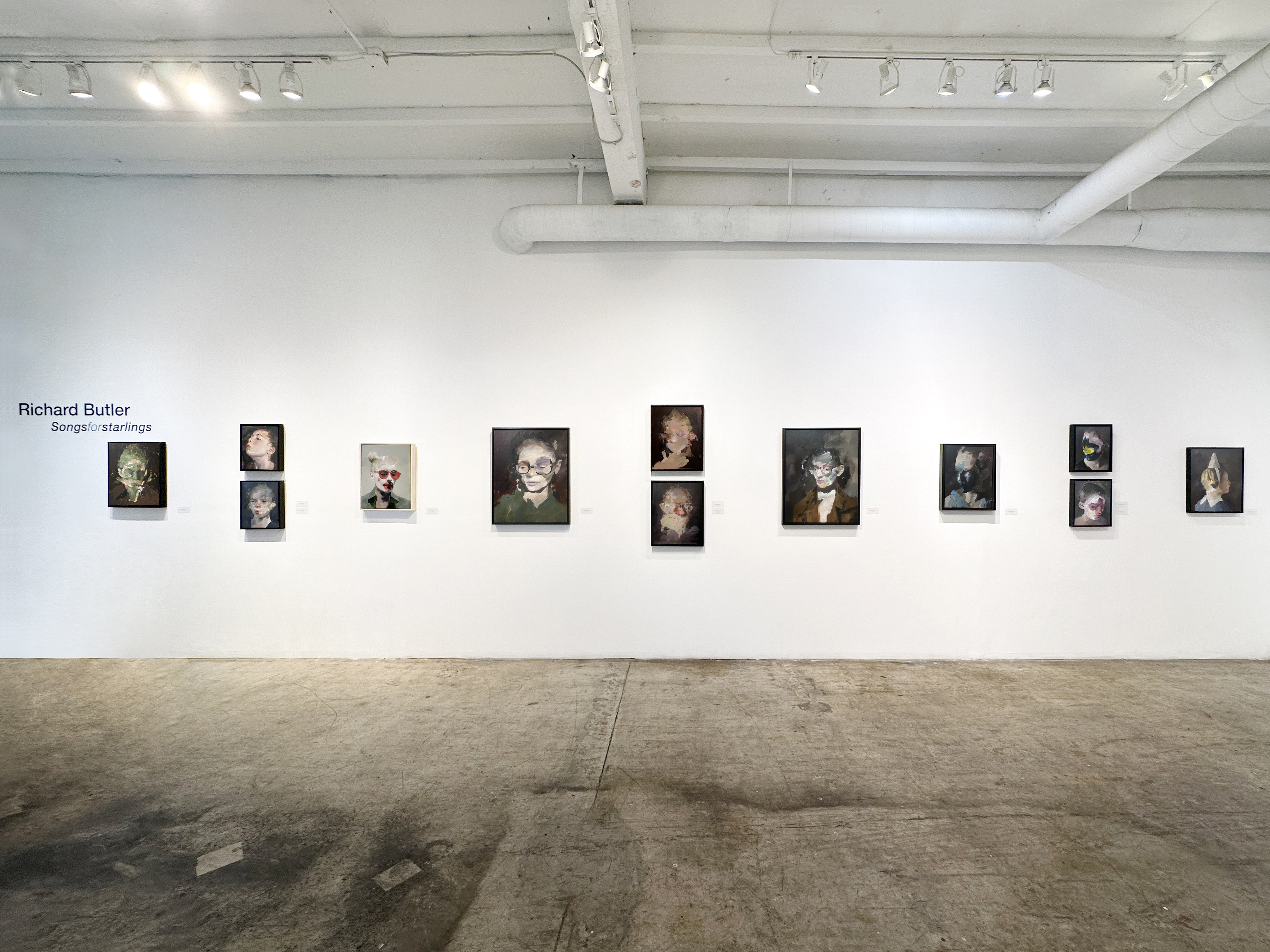 Installation view, Richard Butler: Songsforstarlings. Photo courtesy of the artist and Aliona Ortega Fine Art, Miami.
Installation view, Richard Butler: Songsforstarlings. Photo courtesy of the artist and Aliona Ortega Fine Art, Miami.
Bird Chatter
In these paintings, Butler lays bare the complexities of personal identity. He shows us the inside, where the starling’s jumbled warbling and loud whistles are only chatter — chatter meant to boast, to impress, to deceive, and to keep rivals at bay. The essential metaphor is the bird’s song, a melody that soars above worldly constraints and represents human desire for freedom.
Butler’s figures turn away from the viewer, staring listlessly from the narrow depth of the picture, or fixing an unexpectedly pale and empty gaze past the viewer. Butler’s method is rigorous. Initially he takes photographs of family members and himself, before digitally “improving” them with photo editing software, moving and adjusting all aspects of the image, adding and subtracting content. When satisfied, Butler replicates his images onto small, stretched linen canvases, where his life-sized silhouettes of figures come to life with thin layers of paint, scumbles, dashes and flecks of light. That’s it. Simple as it sounds, Butler’s portraits are complex, mysterious and haunting. The small size and darkness of the works pull you in to look closer — so close that solitary figures, who looked so lost and ethereal, pull you into their silent, static world.
What are we to make of these intimate images? And who are they? We see echoes of his daughter Maggie and wife Erika and the artist himself. Achieving a startling sense of psychological deconstruction, these images approach a distorted abstraction of realism.
Butler’s exploration of portraiture is unexpected. He changes how we look at people. His distortions suggest that our true selves always elude capture.
 Installation view, Richard Butler: Songsforstarlings. Photo courtesy of the artist and Aliona Ortega Fine Art, Miami.
Installation view, Richard Butler: Songsforstarlings. Photo courtesy of the artist and Aliona Ortega Fine Art, Miami.
Metamorphosis and Change
The only permanent thing in nature is metamorphosis or continuous change. Richard Butler’s paintings are an exploration of change itself. Even as he grounds his narratives in the daily life of family, and the metamorphosis of time, Butler identifies the cumulative changes that will ultimately sweep our lives into the abyss of time.
For Butler, these portraits blur the lines of representation and imagination. At the same time, they allude to the complex conjunction of influences, circumstances, actions, and experiences that shape our lives. The age of innocence is captured (Vogelstar and Vogelstar2), teetering on the verge of adulthood and awakening (10). That poignant moment is at the core of Butler’s vision, enabling him to expose irreverent honesty, subtle humor, and feelings about what it means to live in the contemporary world.
The artist challenges use to recognize flux and change as fundamentals of life. Circumstances shift, fortunes ebb and flow, and our identities ceaselessly evolve from one stage of life to another.
Butler leaves us quite a bit of room to think and speculate on his works. “My process is that I work initially from photographs. I take photographs of my subject, most often my daughter. I then import these images into Photoshop. This is where I mess around with scale, composition and any patterns or backgrounds, etc. I have a fairly good idea from this what the final painting may look like … Paint has qualities of its own, as does the application of paint. I like to see brush marks and gesture. I feel if one is making a painting, you should maximize the particular qualities that the medium has to offer. The actual color of the painting is always very different to the image I am working from. Also the process of making a painting always offers up its own set of problems to be solved in a direct way on the canvas” (11).
Richard Butler’s primary subject matter is the human face, and his portraits often depict women and children. His figures are often shown in close-up, with their eyes averted or downcast. This creates a sense of intimacy and vulnerability, and invites the viewer to contemplate the subject’s inner thoughts and emotions.
Butler’s paintings are also notable for their use of color, pared down to an elegant minimalism. He uses a limited palette of dark, muddy earth tones, which creates a sense of quiet mystery and depth. Butler’s paintings have been compared to the work of artists such as Egon Schiele, Francis Bacon, and Lucian Freud. Butler’s work is both deeply personal and universally relatable, capturing human condition in all its complexity. Butler’s paintings are a reflection of his inner world, and they offer viewers a glimpse into his unique perspective on life.
 Richard Butler, Untitled (Asongforthestarlings), 2023. Oil on linen, 30 x 24 in. Courtesy of the artist and Aliona Ortega Fine Art, Miami.
Richard Butler, Untitled (Asongforthestarlings), 2023. Oil on linen, 30 x 24 in. Courtesy of the artist and Aliona Ortega Fine Art, Miami.
Ultimately, Butler’s subject is humanity – portraits, self-portraits, and anonymous figures, literary and mythic characters who reveal the weight of life’s baggage. We feel the melancholy isolation of these figures, balancing static silence and gestural cacophony, underscoring the contradictions implicit in painting – realism and illusion, image and meaning.
Butler interlaces visual metaphors and fundamental values of the past with those of the present. In painting portraits, he reveals an intensive self-dialogue — focusing on how the exterior can reveal the interior. This labored and psychological process scars Butler’s figures, robbing them of individuality, history and memory. He refers to his figures as “everyman” and “everywoman.”
Subjects become emotional images of transient beauty laboring to patch and preserve a restless equilibrium that has been fragmented through the passage of time and experience. In Keepingthesecret and Keepingthesecret2, we see Maggie’s and Butler’s faces as imposing edifices of scars and scrapings, callouses and patches, as they cover their mouths. These difficult and beautiful portraits with all their imperfections exist on the level of a hallucinatory reality. No eye contact, no dialogue. They are keeping the secret.
Part anxiety and part complacency, Butler’s other portraits layer our past and our present to reference our future. The artist thinks of these dark portraits with abstract elements masking parts of the face as self-portraits — that they reflect feelings from his “own psyche.” From the innocence of childhood to the ashes of past lives, Butler’s portraits document a search for meaning, and self-reflection. “When I make a painting I am always trying to translate a particular feeling, one that strikes a chord in me. An image that to me has a certain ‘truth’ to it … that resonates with me in an honest and direct way” (12).
Time and Consequences
Butler’s paintings are about time and change and consequences. Seemingly innocuous objects and items of clothing take on portentous significance. These figures speak without mouths (Thesecret, 2022). They hear without ears (Confessional, 2014). They see without eyes (Keepingthesecret, 2020), from behind eyeglasses (Maggieingreen, 2022), rose-colored glasses (Theoptimist, 2023), goggles (Thelastcrusade2, 2023), church confessional screens (Confessional, 2014), and from corners in the dark (Girlinthecorner, 2023).
“I personally feel my paintings have a certain melancholy, although it is not through planning entirely. It is only when I can stand back from a painting and ‘feel’ a certain presence and certain empathy for the subject that I consider the painting to be ‘working.’ There is a certain quiet and depth that I am striving for. And, I suppose, a particular sadness” (13).
Some of Butler’s most inexplicable images suggest the profound transformations of values and social mores that have produced the modern consciousness, a world tormented by its loss of faith and reason. Using latticed partitions, confessional screens, and face paint, Butler builds a labyrinth of psychological layers in which his subjects are constrained by levels of control, obscured views, limited vision, barriers, screens, and partitions.
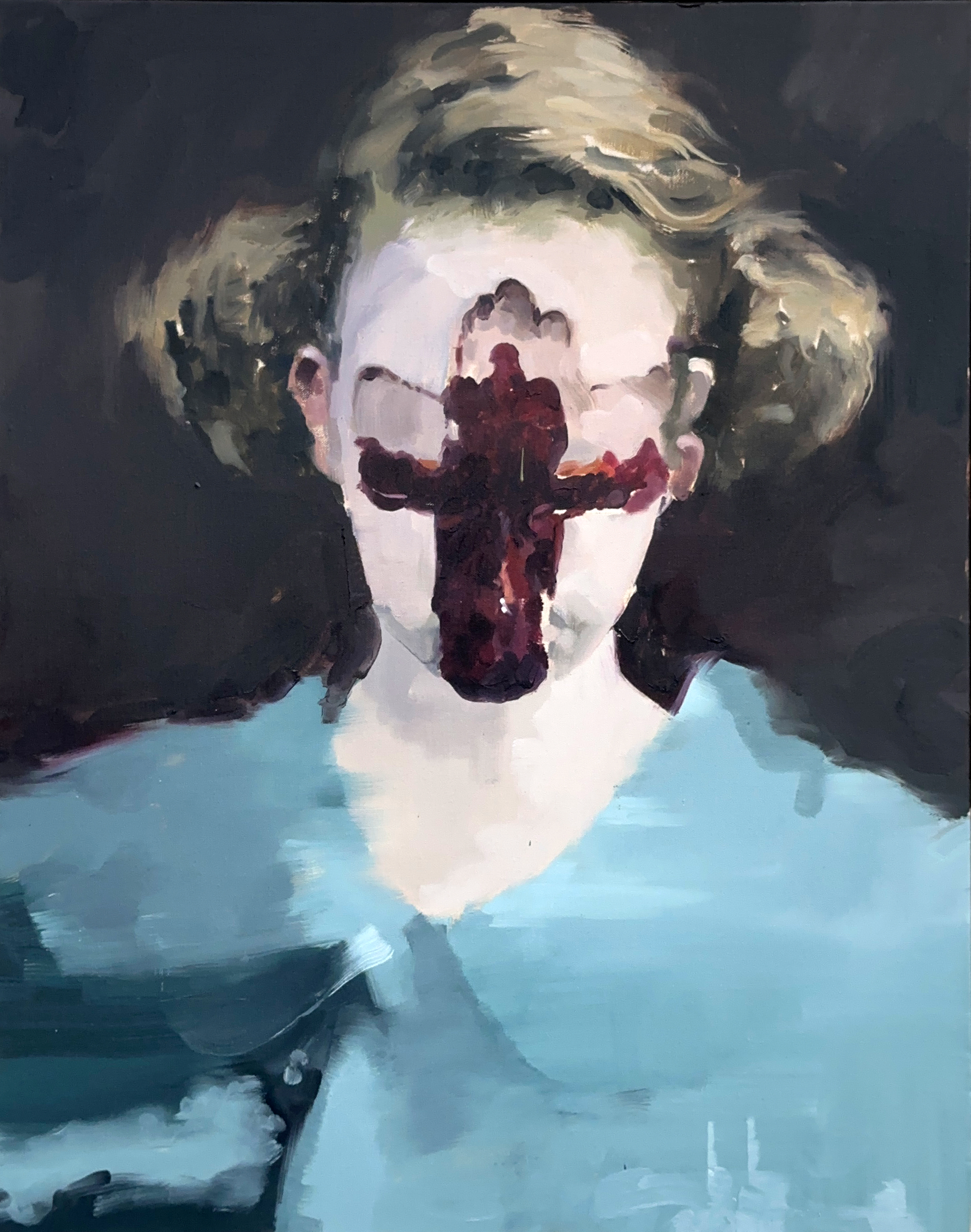 Richard Butler, Asongforthestarlings, 2023. Oil on linen, 30×24 inches. Courtesy of the artist and Aliona Ortega Fine Art, Miami.
Richard Butler, Asongforthestarlings, 2023. Oil on linen, 30×24 inches. Courtesy of the artist and Aliona Ortega Fine Art, Miami.
Whole faces are marked with the ash crosses of Lent (Ashwednesday, 2023),
an essential for repentance, and a remembrance of mortality. Butler combines classic beauty, the surreal, and grotesque in Asongforthestarlings (2023), with a facial cross of blood and ashes meant to represent penance for our sins and inevitable mortality. “Remember that you are dust, and to dust you shall return.”
For Butler, these portraits blur the lines of representation and imagination. At the same time, they allude to the complex conjunction of influences, circumstances, actions, and experiences that shape our lives. “Francesco Clemente once said that he had done so many self-portraits that by now it was like looking at a cipher. You see it so much that you don’t really read it … the feeling I’m after is a melancholy, a void we have in ourselves” (14). What the artist refers to as “the void,” echoes in our struggles to understand ourselves. Butler’s own life-long journey of personal growth and transformation – as an artist, singer/songwriter, son, brother, husband, and father – portrays a nuanced exploration of inner conflict, and the yearning for meaning and connection.
In Butler’s latest paintings, color appears more jewel-like, with the introduction of soft mauves and pinks, pale blues, and dashes of brilliant yellow and Prussian blue (Euphonia, 2023). The dry, chalky greens of Viridiana (2021) are activated by staccato brushworks, daubs and dashes of fractured pigment that engulfs the woman’s face. White flecks scatter like feathery dandelion seeds released from a white puffball by the winds. Or are they shooting stars reflecting off the beautiful iridescent plumage of the starling?
This same fracturing and rapid brushstroke are even further pronounced by thin, white, agitated outlines that shimmer against patches of rich dark umber and inky black (Satyratthegatesofhell, 2023). And this newfound nervousness really amps up in Theghostofelectricty (2023).
It seems that Richard Butler’s latest paintings have taken on a quiet, but intense, life of their own. The result is a treasury of realist/romantic/symbolist rare gems. Here, Richard Butler’s tremendous gifts of reflection and imagination crowd out all feelings of melancholia. Instead, we feel a sympathetic admiration for these deeply human images. WM
Notes
1. Richard Butler, email message to author, October 23, 2023.
3. Richard Butler, “Love My Way,” track 1 on The Psychedelic Furs third studio album Forever Now, 1982, Columbia/CBS.
4. T.S. Eliot, “The Hollow Men,” in The Complete Poems and Plays 1909-1950 (New York: Harcourt, Brace & World, Inc., 1971), stanza 1, p. 56.
6. Oscar Wilde, The Picture of Dorian Grey (New York: Tribeca Books, 2010), p. 23.
8. Farid Ud-Din Attar, The Conference of The Birds. The Clear Light Series (Boulder: Shambhala Publications, Inc., 1971), p. 135.
9. Avicenna (Ibn Sina), “The Recital of the Bird,” in Henry Corbin, Avicenna and the Visionary Recital: (Mythos Series), ix-xiv. (Princeton NJ: Princeton University Press, 1960), pp. 168-203.
10. In 1784, Wolfgang Amadeus Mozart bought a pet starling, which he named Vogelstar, the German word for the starling species. The starling learned to sing the theme from his Piano Concerto no. 17 in G major. For three years, the starling lived with Mozart, influencing his work and serving as his companion and muse.
Richard Butler | Songsforstarlings opened at Aliona Ortega Fine Art in Wynwood Art District, Miami, on November 4th, and remains on view until December 10th, 2023.

